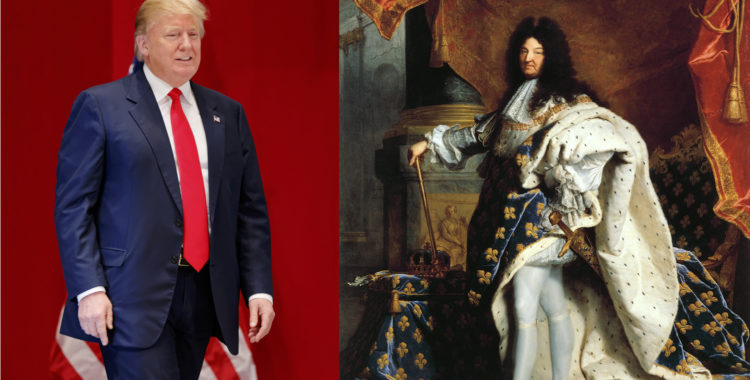
Trump, Taste and Power
December 04, 2016
by Diana Greenwald | Filed in: Current Events
Donald Trump’s home in Trump Tower is said to have been inspired by the Palace of Versailles. A mix of real Louis XIV antiques and pieces inspired by the Sun King‘s furniture populate the top of the glass skyscraper. It, therefore, seems appropriate to use historical analyses of the French monarch’s style and its role in his political maneuverings to understand how Donald Trump’s taste and style play into his political identity.
In Taste and Power: Furnishing Modern France historian Leora Auslander writes: “Taste has been, for at least the last two hundred years, a term laden with contradictions. It has been understood to be innate and emotional yet capable of improvement through education; individual and idiosyncratic yet absolute; transcendent of time and space yet socially constituted.” Auslander tracks how taste and style—which she describes as “historical and specific, resulting from either collective effort or individual genius, [and] almost always identified retrospectively”—were deployed throughout French history to define and support political different political regimes and social structures. [1]
Auslander’s analysis of how taste and style can be deployed to justify a regime and the ruler in charge of that regime can illuminate some of the behaviors of President-elect Donald Trump. My previous post described how Trump’s taste and style offended other elites. This post will describe how it projects and reinforces his political ideas and agenda. Several commentators during the election noted how the nostalgia-infused “Make America Great Again” was echoed in candidate Trump’s wardrobe. Time magazine assembled a slideshow on the topic, and the Washington Post published a thought-piece about the President-elect’s staunchly 1980’s style. Colorful power ties, suits with boxy cuts, and flamboyant hairstyles reek of Wall Street. Many people have asked how Americans from lower-income brackets living very far from Manhattan could have chosen to vote for a flashy billionaire like Trump? Answers to this question have become New Yorker thought-pieces and meditations on “Trump’s America.” Most of these analyses have focused on the working class’ growing economic disenfranchisement and racist tendencies among white voters.
However, perhaps Auslander’s analysis of Louis XIV’s management of his aesthetic image and consumption patterns can provide a novel answer to the question: why did America’s working and middle classes vote for a billionaire to “Make American Great Again”? Auslander writes:
Trump has made his fortune by selling a luxurious lifestyle that resembles his own, whether it is condominiums, steaks or men’s clothing. He valued his “brand” at $3.3 billion and has made much of his money by selling his name to other developers’ projects and helping them promote their business. Even his reality show—The Apprentice—allowed normal people to gain access to the Trump lifestyle by competing for a job in his company. While it may be dated, Trump’s style exudes the Gordon Gekko conviction that “greed is good” and that like Charlie Sheen’s Bud Fox character, we too can get rich if we follow this ethically dubious dictum. Trump’s personal style and his ability to sell it hark back to a Bonfire of the Vanities time where flash and wealth is accessible to those with no firm qualifications or concrete skills but who can successfully hustle and speculate.
“In the consumption of goods of style, the king had a delicate line to tread between preserving the uniqueness of his self-representation through objects and his need to demonstrate power by allowing certain privileged people to have things that resembled his own. Just as the crown reinforced its power through granting and undermining monopolies, and just as it acknowledged the limitations of its power posed by the church, the corporations, and the nobility through granting special factors to each, so the crown could not completely monopolize style either but rather judiciously allowed and even encouraged emulation. The systems of production, distribution, and consumption of goods of style in the ancient régime thus illustrate the complexity of the everyday workings of absolutism as well as the ways in which its apparent weaknesses could become its strengths, and its strengths its weaknesses.”[2]
Ultimately, Auslander’s conclusions about absolutism can also be applied to the Trumpian pitch to voters. What commentators considered its apparent weaknesses—the vulgar display of wealth built on risky speculation with other people’s money—became its strengths. While its apparent strengths—the presentation of the President-elect as a brazen Washington-outsider identity—may be its downfall if Trump is unable to deliver on the economic promises he has voiced and projected with power suits, available for purchase at trump.com.
[1] Leora Auslander, Taste and Power: Furnishing Modern France (Berkeley, CA: University of California Press, 1996), 1 -2
[2] Ibid., 32
Valuing the National Endowment for the Arts >>
<< Making America Gilded Again: Aesthetics, Economics, and Trump’s Style
